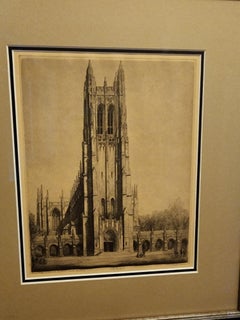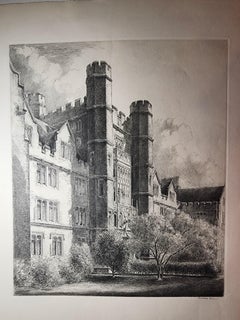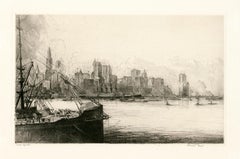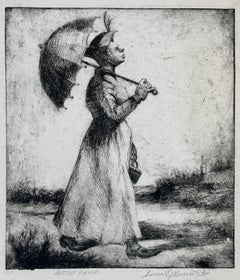Louis Orr Art
American, 1879-1961
Louis Orr is celebrated for his large, detailed works of Paris, and domestically, for his extensive series of etchings of North Carolina landmarks. Orr studied at the Hartford Art School, the Art Students’ League in New York and the Académie Julian in Paris. Orr spent much of his life living between Hartford, Connecticut and Paris.
to
5
5
4
3
1
1
1
European Home
By Louis Orr
Located in Raleigh, NC
Excellent condition and nicely framed
Category
1940s Realist Louis Orr Art
Materials
Etching
The Chapel, Duke University, Durham, North Carolina
By Louis Orr
Located in Raleigh, NC
RGRFineArts is pleased to offer the etching The Duke Chapel from the Centennial Edition of 100 prints.
Excellent condition and nicely framed with Tru Vue ultraviolet filtering glass.
Category
1930s American Realist Louis Orr Art
Materials
Etching
St. Mary's Episcopal School for Girls, Raleigh, North Carolina
By Louis Orr
Located in Raleigh, NC
RGRFineArts is pleased to offer this Louis Orr etching that rarely appears on the market.
It has been stored in a folder since publication and is in pristine condition.
Category
1940s American Realist Louis Orr Art
Materials
Etching
Duke University Medical Center Facade
By Louis Orr
Located in Raleigh, NC
RGRFineArts is pleased to present a fresh never framed etching of the Duke University Medical Center facade from the Duke Centennial Series.
Other images from the series are availab...
Category
1940s American Realist Louis Orr Art
Materials
Etching
New York (from Ports of America)
By Louis Orr
Located in Myrtle Beach, SC
Louis Orr, 'New York' (from the portfolio 'Ports of America', published by Yale University Press, 1928), etching, 1925, edition not stated. Signed and titled in pencil. Signed in the...
Category
1920s Realist Louis Orr Art
Materials
Etching
Related Items
Sunday Morning
Located in Wilton Manors, FL
Sunday Morning. Title: Sunday Morning
Artist: Dox Thrash (American, Griffin, Georgia 1893–1965 Philadelphia, Pennsylvania)
Printer: Sam J. Brown (1901-1994).
Date: ca. 1939.
Medium: Drypoint
Dimensions: sheet: 12 5/8 x 10 5/8 in. (32 x 27 cm)
plate: 8 7/8 x 7 7/8 in. (22.5 x 20 cm)
This is the most heavily inked, atmospheric example known to exist. Unique, unsigned example from the collection of artist Samuel J. Brown.
Dox Thrash (1893–1965) was an African-American artist who was famed as a skilled draftsman, master printmaker, and painter and as the co-inventor of the Carborundum printmaking process.[1] The subject of his artwork was African American life. He served as a printmaker with the W.P.A. at the Fine Print Workshop of Philadelphia. The artist spent much of his career living and working in Philadelphia, Pennsylvania.[1]
Early life
Dox Thrash was born on March 22, 1893, in Griffin, Georgia.[2] He was the second of four children in his family. Thrash left home at the age of fifteen in search of work up north. He was part of the Great Migration (African American) looking for industrial work in the North.
The first job that Thrash got was working with a circus and a Vaudeville act. In 1911, at the age of 18, he moved to Chicago, Illinois.[3] He got a job as an elevator operator during the day, and used this source of income to attend school.[3] In 1914 he attended the School of the Art Institute of Chicago.[1]
In 1917, the United States declared war on Germany and entered World War I. In September 1917, at the age of twenty-four, Thrash enlisted in the army.[3] He was placed in the 365th Infantry Regiment, 183rd Brigade, 92nd Division, also known as the Buffalo Soldiers.[1] During combat, Thrash suffered shell shock and a gas attack, but was not permanently injured.
Career as an artist
Front cover of Dox Thrash: An African American Master Printmaker Rediscovered, by John Ittmann.
After having served in the war, Thrash qualified as a war veteran and enrolled in the Art Institute of Chicago with the support of federal funding.[3] After finishing his education, he traveled intermittently from Georgia to Chicago, Boston, New York, and finally Philadelphia, working odd jobs - experiences that provided him with subject matter to later paint. Settling in Philadelphia by 1925, he took a job working as a janitor. In his free time, he continued his art career and used his talent to create emblems, such as the one for the North Philadelphia Businessmen's Association, and posters in exhibitions and festivals, including the 2nd Annual National Negro Music Festival and the Tra Club of Philadelphia.[1] This gained him local recognition and opened doors for new artistic endeavors. By 1929, Thrash was attending nightly classes within these clubs, namely with Earl Horter of the Graphic Sketch Club, now known as the Samuel S. Fleisher Art Memorial.[3]
In 1937 Thrash joined the government-sponsored Works Progress Administration (WPA)'s Federal Art Project.[4] Through the WPA, Thrash began working at the Fine Print Workshop of Philadelphia.[5] At the Fine Print Workshop of Philadelphia, Thrash, along with Michael J. Gallagher and Hugh Mesibov, began experimenting and co-inventing the process of carborundum mezzotint, a printmaking technique.[1] Carborundum printmaking uses a carbon-based abrasive to burnish copper plates creating an image that can produce a print in tones ranging from pale gray to deep black. The method is similar to the more difficult and complicated mezzotint process developed in the 17th century. He used this as his primary medium for much of his career and created his greatest works with it. One of his first pieces employing this nascent technique was his anonymous self-portrait entitled Mr. X.
With this new technique, the three gained increasing recognition as they published more and more graphics within newspapers and featured more and more pieces within exhibitions. Their works often featured subtle commentaries about social and economic exploitation regarding the contemporary politics of the Great Depression and the Second World War. By 1940, Thrash, Gallagher, and Mesibov all began to gain attention in local circles for their carborundum prints, although the role that each artist played in the development of the process was left unclear.[6]
In 1960, Thrash participated in a show at the Pyramid Club, a social organization of Black professional men that held an annual art exhibit starting in 1941. Others on hand were Howard N. Watson, Benjamin Britt, Robert Jefferson and Samuel J. Brown Jr.
Thrash spent the later years of his life mentoring young African American artists. He died on April 19, 1965, in Philadelphia, Pennsylvania.[2] He was posthumously honored almost 40 years later in 2001 with a major retrospective, titled Dox Thrash: An African-American Master Printmaker Rediscovered, at the Philadelphia Museum of Art.[7]
Thrash's work was included in the 2015 exhibition We Speak: Black Artists in Philadelphia, 1920s-1970s at the Woodmere Art Museum.[8]
Relation to Alain Locke and the New Negro Movement
This section needs additional citations for verification. Please help improve this article by adding citations to reliable sources in this section. Unsourced material may be challenged and removed. (June 2022) (Learn how and when to remove this template message)
Alain LeRoy Locke (1885-1954) was an intellectual, professor and author who espoused that African Americans, specifically artists, to capture the personality, lives, and essence of their people in The New Negro. He explained “The Negro physiognomy must be freshly and objectively conceived on its own patterns if it is ever to be seriously and importantly interpreted. Art must discover and reveal the beauty which prejudice and caricature have overlaid.”[9] What Locke is expressing here is not only the call for black artists to overcome racial prejudices via positive artistic representations of blacks, but that the actual African American individual like Thrash portrayed the lives of fellow blacks, and had the power to propagate this idea of the New Negro, as Locke explains, “There is the possibility that the sensitive artistic mind of the American Negro, stimulated by a cultural pride and interest, will receive…a profound and galvanizing influence.”[10]
In his shadowy carborundum mezzotint Cabin Days, Thrash depicts a southern black family on the porch of their shack-like home in a rural landscape. The man, woman, and child, clutched tenderly to the female figure's breast, create an intimate scene highlighted by the bright cleanliness of the laundry hanging behind them. Placed in front of the drying laundry, they are framed by one aspect of the hard work accomplished during the day. Close to one another, staring collectively outward at the Southern landscape, they, and their laudable priorities of cleanliness and family, are made the bright focal point in the poor, unstable atmosphere. Such inner warmth is seemingly incompatible with the family's crooked and disheveled surroundings, and their fuzzy appearance with a lack of facial detail makes the scene into a general archetype for rural southern blacks living conditions and qualities. Thrash was referencing an experience common to thousands of black families in rural occupations at the turn of the 20th century, often forced into slavery-like tenant farming as their only means of livelihood in the racist South. The “uneven clapboards, leaning porch, broken shutter, and uprooted fence” are rife with instability, much like the post-slavery economic and social systems of the South, making it clear that for African Americans, “the house is not the home; rather, the figures on the porch represent family unity and continuity”.[10] In this way, Thrash is able to not only champion the positive qualities of blacks in the family setting but underscore this with a symbolic look at their disadvantaged situation, making it all the more impressive that they persevere. Thrash symbolically depicted harsh realities for the African American at this transitional point in history while conferring a sensitive rendering of their humanity, akin to any other race, despite its utter denial by American society.
Through softer tempera washes like A New Day, he literally and figuratively paints a picture of a black family transitioning from the South to the North during the Great Migration, making a hopeful, daring leap to attempt to be equal members of the society that has historically oppressed them. On the left side of the canvas lie muddled farm houses and plow handles, embodiments of their rural life of tedious hard labor behind them, fading to gray. Their hopeful gazes “…convey the optimism of the scores of African Americans who left the countryside to pursue better job opportunities, health care, and education in urban centers”.[6] The stance of the figures, with their chins raised in a dignified gesture towards cityscape ahead suggest a confidence and ambitiousness in their collective futures in this new northern industrial terrain. Even the child, clutched securely in the arm of the mother figure against her breast is not only serenely grinning, but calm enough to appear to gently doze, confident in that the journey ahead will result positively, poses no threat. The exposed arm of the woman is notable as well, being unusually thick and muscular, along with the general proportions of the kneeling father, who position on the ground appears not pleading but rather in a slightly exhausted, but upright gratefulness for the promise ahead. Thrash makes it clear that this family has traveled a long way, but is not depleted; rather they are strong and preparing for further hard work and hopeful success ahead. They are the quintessence of the New Negro, in that they are not only journeying forward to seize previously unobtainable opportunities that will enhance their lives, but the manner with which they hold themselves provokes a certain level of warranted respect for their humanity, from the viewer.
In fact it was the strength of his fellow African Americans that Thrash often emphasized, amongst other positive characteristics in the face of adversity in personal portraits. Through his carborundum print Life, he depicts a neatly dressed black girl reading...
Category
1930s American Realist Louis Orr Art
Materials
Etching
'Spiderboy' — 1930s American Realism, New York City
By James Allen
Located in Myrtle Beach, SC
James Allen, 'Spiderboy', 1937, etching, edition 40, Ryan 86. Signed in pencil. A superb, richly-inked impression, on cream laid paper, with full margins (1 1/4 to 2 7/8 inches). A s...
Category
1930s American Realist Louis Orr Art
Materials
Etching
'The Connectors' — 1930s American Realism, New York City
By James Allen
Located in Myrtle Beach, SC
James Allen, 'The Connectors', 1934, etching, edition not stated, Ryan 66. Signed in pencil. A superb, richly-inked impression, on handmade, cream laid paper, with margins (1/2 to 1...
Category
1930s American Realist Louis Orr Art
Materials
Etching
Soaring New York
By Howard Norton Cook
Located in New York, NY
Howard Cook (1901-1980), Soaring New York, aquatint, soft0ground etching, roulette, 1931-2; signed, dated and annotated “imp” in pencil lower right, titled lower margin. Reference: D...
Category
1930s American Realist Louis Orr Art
Materials
Etching
"Sherman Rose" Adobe, Monterey California - Signed 1923 Original Etching
By Ferdinand Burgdorff
Located in Soquel, CA
Beautiful early 20th Century etching on vellum of the Monterey Bonifacio Adobe known as The Old Sherman Rose House, with climbing roses, by Ferdinand Burgdorff (American, (1881 - 197...
Category
1920s American Realist Louis Orr Art
Materials
Paper, Etching
H 16 in W 17.5 in D 0.5 in
Munichau (Austria)
By Luigi Kasimir
Located in San Francisco, CA
This artwork titled "Munichau (Austria)" 1926, is a color etching on paper by Austrian artist Luigi Kasimir, 1881-1962. It is hand signed in pencil by the artist's estate at the lower center. The plate mark (image) size is 11.5 x 11.5 inches, framed size is 21 x 20.75 inches. Custom framed in a wooden gold frame, with grey/green matting . It is in Excellent condition.
About the artist.
Luigi Kasimir was born in 1881 at Pettau, today Ptuj, Slovenia, then a part of the Austro-Hungarian monarchy. He inherited his talent from his ancestors; his grandfather was a painter and a poet, and his father an officer in the Habsburg army, who later became a professional painter. Kasimir attended the Vienna Academy of Art where he studied under Wilhelm Unger, who introduced him to the technique of the coloured etching, and also to his future wife, the artist Tanna Hoernes.[1] He died in 1962 in Grinzing, a suburb of Vienna.Kasimir was among the first to develop the technique of the coloured etching. Before this, prints were usually hand-coloured with the colour being applied in a casual, haphazard manner. Kasimir would first create a sketch usually in pastel, he then transferred the design on as many as four to six plates, printing one after the other and applying the colour on the plate, all done by hand.
Kasimir is mainly famous for his etchings, but he also produced some oil painting, as well as some pastels. One of his favourite genres was the landscape, or veduta. He demonstrated a predisposition street scenes, and tourist landmarks. He depicted places from all over Europe, mainly Italy, Austria, and Germany. He also travelled to the United States to do a series of etchings of famous sights ranging from urban landmarks such as New York City skyscrapers, to natural wonders like Yosemite Valley. Luigi Kasimir’s etchings...
Category
Early 20th Century Realist Louis Orr Art
Materials
Etching
"Les Patineurs, " Etching of a Winter Landscape signed by James Ensor
By James Ensor
Located in Milwaukee, WI
"Les Patineurs" is a signed etching by James Ensor. It is from the Loÿs Delteil 65 volume XIX and depicts a multitude of skaters on a frozen pond. "Les Patineurs" is the French word ...
Category
Late 19th Century Realist Louis Orr Art
Materials
Etching
Manhattan Bridge
By George Stimmel
Located in Myrtle Beach, SC
'Manhattan Bridge', etching, c. 1920, proofs only. Signed in ink in the image, lower right. A fine, rich impression, in warm black ink, on cream wove ...
Category
1920s American Realist Louis Orr Art
Materials
Etching
Winter Tracery (Milford Connecticut)
Located in San Francisco, CA
This artwork titled 'Winter Tracery (Milford Connecticut)" is an original drypoint etching by noted American artist Philip Kappel, 1901-1981. It is hand signed and titled in pencil by the artist. The plate mark (Image) size is 9 x 12 inches, framed size is 17.25 x 21.25 inches. Custom framed in a wooden light grey frame, with light grey matting and black color fillet. It is in excellent condition.
About the artist:
Philip Kappel — painter, illustrator, printer, writer, and lecturer — was born on February 10, 1901 in Hartford, CT and died in 1981. Kappel is best remembered for his landscapes, portraits, figures, marine, lithography, and etching. He held a teaching position with H. B. Snell, Boothbay, ME Studios, 1923 and 1924. His addresses in 1929 were 500 Fifth Avenue in New York City and, for the summer, care of Philip Little, 10 Chestnut Street, Salem, MA; and in 1935, Sarasota, FL.
Kappel was a pupil of the Pratt Institute Art School in Brooklyn, NY and Philip Little (1857-1942) and held memberships with the North Shore Artists Association in Gloucester, MA; the Marblehead...
Category
Mid-20th Century American Realist Louis Orr Art
Materials
Drypoint, Etching
Agony - The architecture of decay -
Located in Berlin, DE
Jörg Olberg (*1956 Dresden), Agony, 1987. etching, E.A. (edition of 30), 24 x 17 cm (image), 46 x 37 cm (sheet), each signed in pencil lower right "Olberg" and dated "IX [19]87", inscribed lower left "E.A. [Epreuve d'Artiste]".
- minimal crease and dust stains in the broad margin
- The architecture of decay -
About the artwork
Jörg Olberg draws here the sum of his artistic study of the Berlin ruins, which were still present in the cityscape well into the 80s. With his work "Agony" he creates an allegory of decay. Positioned in the landscape of ruins, a ruined house grows before the viewer, rising like the Tower of Babel into the sky, its roof and gable brightly illuminated by the sun. But already the roof shows mostly only the rafters, and as the gaze is drawn further down, the building visibly disintegrates, the beams protruding in all directions looking like splintered bones. Slowly but inexorably - in agony - the house will collapse in on itself and become nothing more than the burial mound of itself. At the same time, the small-scale stone composition and the plaster form a pattern-like ornamentation of decay.
The tension in the picture is fed by the counter-movement of growth and collapse, which is heightened by the dramatic formation of clouds. The swirls of clouds are reminiscent of a world landscape...
Category
1980s Realist Louis Orr Art
Materials
Etching, Paper
Heiligen Bluts
By Luigi Kasimir
Located in San Francisco, CA
This artwork titled "Heiligen Bluts" 1948, is a color etching on Wove paper by Austrian artist Luigi Kasimir, 1881-1962. It is hand signed in pencil by the artist at the lower center...
Category
Early 20th Century Realist Louis Orr Art
Materials
Etching
City of Dreams, Etching by John Ross
By John Ross
Located in Long Island City, NY
Artist: John Ross
Title: City of Dreams
Medium: Collagraph, signed, numbered, and titled in pencil
Edition: AP
Size: 38.5 x 27.5 in. (97.79 x 69.85 cm)
Category
1980s American Realist Louis Orr Art
Materials
Etching
Louis Orr art for sale on 1stDibs.
Find a wide variety of authentic Louis Orr art available for sale on 1stDibs. You can also browse by medium to find art by Louis Orr in etching and more. Not every interior allows for large Louis Orr art, so small editions measuring 8 inches across are available. Customers who are interested in this artist might also find the work of Frank Wootton, Georges Schreiber, and Peter Moran. Louis Orr art prices can differ depending upon medium, time period and other attributes. On 1stDibs, the price for these items starts at $700 and tops out at $3,950, while the average work can sell for $1,750.






